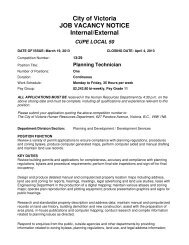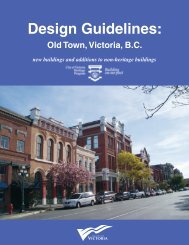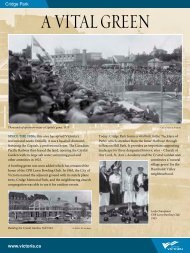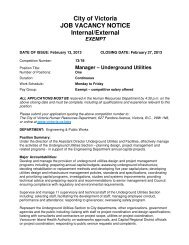Roundhouse Design Guidelines - Victoria
Roundhouse Design Guidelines - Victoria
Roundhouse Design Guidelines - Victoria
Create successful ePaper yourself
Turn your PDF publications into a flip-book with our unique Google optimized e-Paper software.
Alternative transportation choices and implementation of a Transportation<br />
Demand Management (TDM) program are to be pursued. Complete details<br />
of the TDM program are to be contained in the Master Development<br />
Agreement. The following summarizes some of the key elements of sustainable<br />
transportation strategies included in <strong>Roundhouse</strong>:<br />
• The TDM program for the <strong>Roundhouse</strong> includes pedestrians, cycling,<br />
car-sharing and electric vehicles, the harbour ferry, commuter rail, and<br />
sustainable parking strategies.<br />
• Retain the E&N Corridor for rail use.<br />
• Subject to future commuter rail/train planning, build a new Russell’s station,<br />
conveniently connected to local buses.<br />
• Continue the train servicing operation at the <strong>Roundhouse</strong>.<br />
• <strong>Design</strong> for walking, bicycling, and other modes of transportation that<br />
are healthy forms of physical activity, transportation and neighborhood<br />
interaction.<br />
• <strong>Design</strong> traffic-calming elements such through materials and landscaping to<br />
reduce speeding and increase public safety.<br />
• Promote car-free transit by focusing on circulation patterns, connecting<br />
walkways and paths to places of interest, creating bike lanes, and<br />
encouraging public transit.<br />
1.1.5 Green Building Opportunities<br />
Buildings are where most resources, including water, energy, materials, and land,<br />
are consumed within a community. People spend virtually all of their time<br />
in these buildings therefore, they are incredibly important determinants of<br />
resource use, production of waste materials and pollutants, personal health, and<br />
employee productivity. All buildings shall be designed to meet green building<br />
design standards as set by LEED or similar standards.<br />
• <strong>Design</strong> buildings to reduce consumption levels of water, materials and<br />
energy use during their life cycle, operation and disposal.<br />
• <strong>Design</strong> for technology upgrades with convenient cable pulls and electrical<br />
capacity. As new technology becomes available, retrofitting should occur.<br />
• Identify building and site synergies and complementary land uses for<br />
maximizing opportunities for energy performance.<br />
• Integrate building features to educate occupants and visitors about the<br />
sustainable building components.<br />
• Provide improved comfort and health through premium indoor<br />
environmental quality.<br />
• Utilize the LEED Standard or similar standards as guidelines to measure<br />
green buildings.<br />
• Consider utilizing holistic energy efficiency strategies to achieve and exceed<br />
standards.<br />
52<br />
R O U N D H O U S E D E S I G N G U I D E L I N E S J u l y 2 0 0 8




![Victoria-Changsha Friendship City Signing Ceremony [PDF - 143 KB]](https://img.yumpu.com/50875401/1/190x245/victoria-changsha-friendship-city-signing-ceremony-pdf-143-kb.jpg?quality=85)
![Victoria's Paralympic Torch Relay and Celebration Plans [PDF - 64 KB]](https://img.yumpu.com/49727313/1/190x245/victorias-paralympic-torch-relay-and-celebration-plans-pdf-64-kb.jpg?quality=85)

![Cecelia Ravine Park Management Plan [PDF - 1.4 MB] - Victoria](https://img.yumpu.com/46438167/1/190x245/cecelia-ravine-park-management-plan-pdf-14-mb-victoria.jpg?quality=85)

![View the House Names (Alphabetical List) [PDF - 64 KB] - Victoria](https://img.yumpu.com/46379892/1/190x245/view-the-house-names-alphabetical-list-pdf-64-kb-victoria.jpg?quality=85)


![View the list of Private Records (By Number) [PDF - 295 KB] - Victoria](https://img.yumpu.com/42964883/1/190x245/view-the-list-of-private-records-by-number-pdf-295-kb-victoria.jpg?quality=85)




![General Maps (By Subject) [PDF - 40 KB] - Victoria](https://img.yumpu.com/35594040/1/190x245/general-maps-by-subject-pdf-40-kb-victoria.jpg?quality=85)